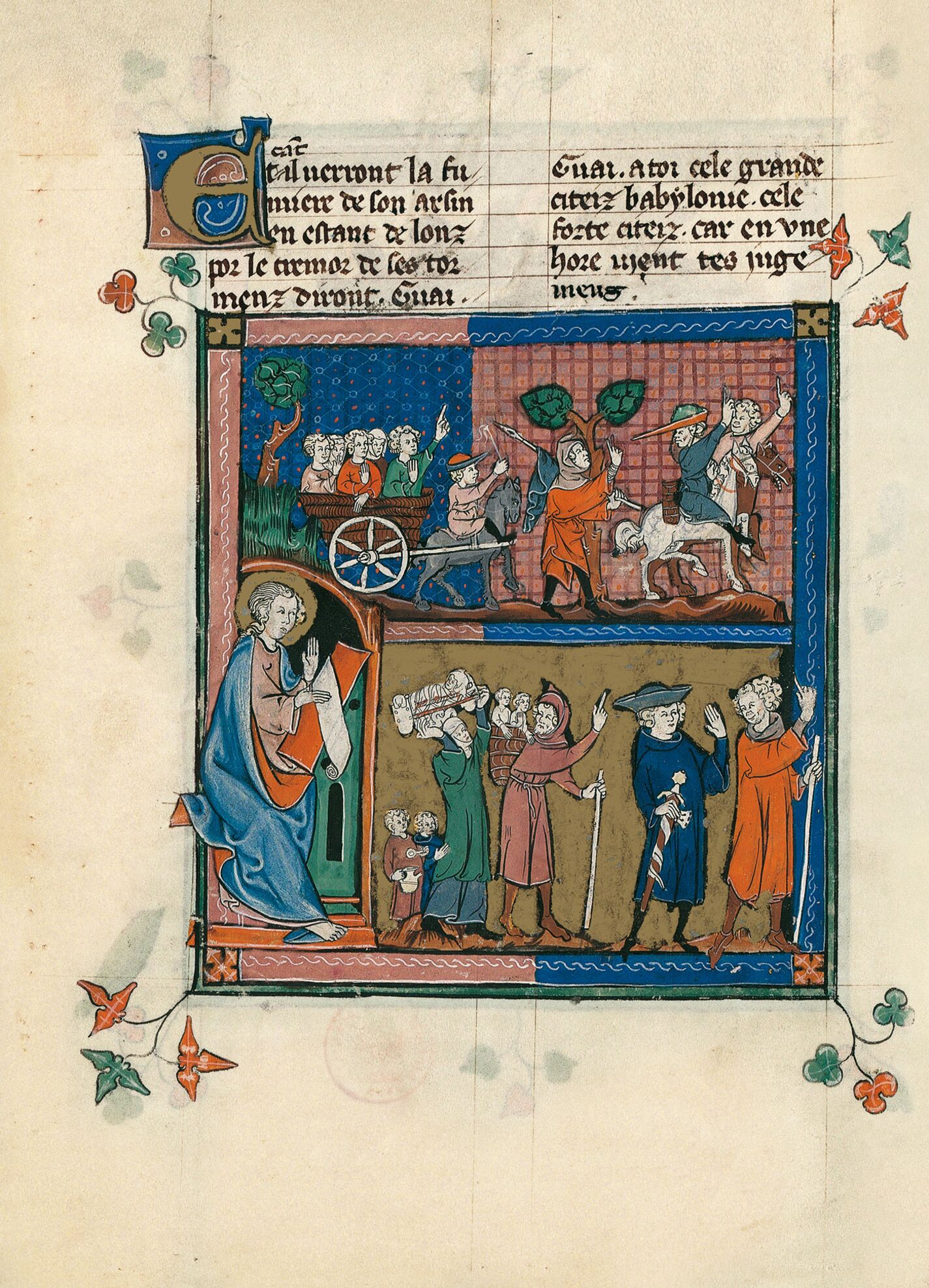Studies of the illustrations in medieval Bibles reveal that movements of people such as Moses leading the Hebrews out of Egypt often gave artists, who always update events, the opportunity to enlarge upon the anecdotic aspects of scenes by referring to the everyday life of the world around them. This is precisely the case in this evocation of the flight of the righteous. The procession beginning on the previous folio continues on two levels on f. 60v, with John the witness relegated to a narrow arcature in the bottom left-hand corner of the composition. Two horsemen, one wearing a falconer’s hat, are followed by people either on foot or squeezed into a lightweight cart, the body of which is apparently made of wickerwork. A family in the lower register is sketched from life. A father carries two small children in a basket on his back, his wife balances a cradle containing her sleeping new-born on her head, whilst the eldest child walks unaided, clutching the handle of a jug and a small, round spoon, with his little brother still hanging onto to their mother’s dress. They all point at Babylon burning on the opposite page (f. 61).
The great harlot is depicted here in her female form. She has fallen off the Beast’s back as he disappears into the blazing inferno. She has dropped her shining gold, goblet into the flames, providing a visual reiteration of the golden cup held in the hand of a dignitary who, like his peers and the kings with him, points at the tormented queen and wails, "Alas! alas! that great city, Babylon, that mighty city: for in one hour is thy judgment come."
Marie-Thérèse Gousset and Marianne Besseyre
Illuminated Manuscripts Research Center, Bibliothèque nationale de France
Fragment of the Apocalypse of 1313 commentary volume

Studies of the illustrations in medieval Bibles reveal that movements of people such as Moses leading the Hebrews out of Egypt often gave artists, who always update events, the opportunity to enlarge upon the anecdotic aspects of scenes by referring to the everyday life of the world around them. This is precisely the case in this evocation of the flight of the righteous. The procession beginning on the previous folio continues on two levels on f. 60v, with John the witness relegated to a narrow arcature in the bottom left-hand corner of the composition. Two horsemen, one wearing a falconer’s hat, are followed by people either on foot or squeezed into a lightweight cart, the body of which is apparently made of wickerwork. A family in the lower register is sketched from life. A father carries two small children in a basket on his back, his wife balances a cradle containing her sleeping new-born on her head, whilst the eldest child walks unaided, clutching the handle of a jug and a small, round spoon, with his little brother still hanging onto to their mother’s dress. They all point at Babylon burning on the opposite page (f. 61).
The great harlot is depicted here in her female form. She has fallen off the Beast’s back as he disappears into the blazing inferno. She has dropped her shining gold, goblet into the flames, providing a visual reiteration of the golden cup held in the hand of a dignitary who, like his peers and the kings with him, points at the tormented queen and wails, "Alas! alas! that great city, Babylon, that mighty city: for in one hour is thy judgment come."
Marie-Thérèse Gousset and Marianne Besseyre
Illuminated Manuscripts Research Center, Bibliothèque nationale de France
Fragment of the Apocalypse of 1313 commentary volume